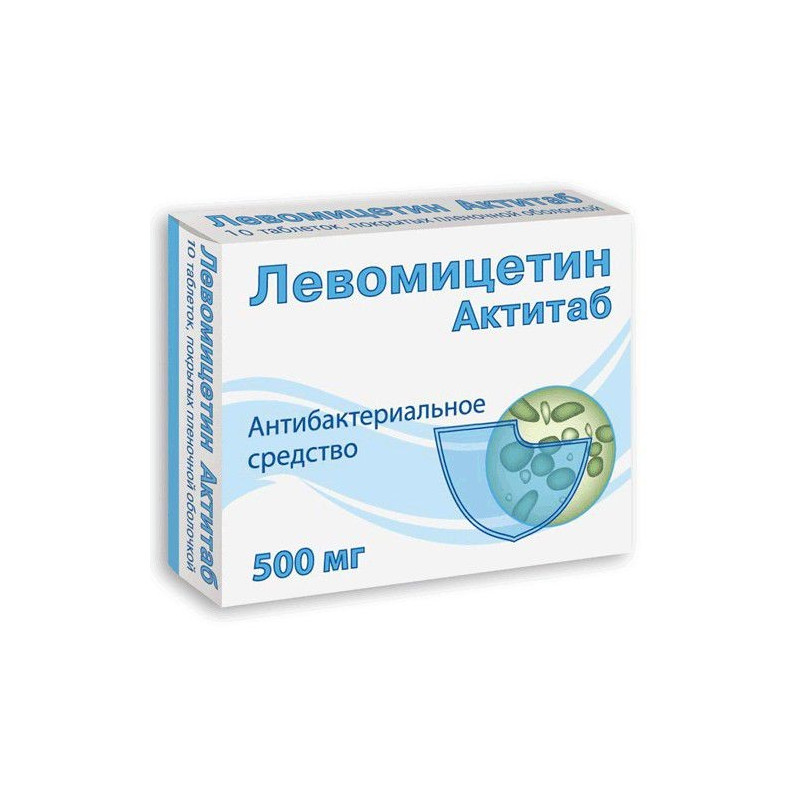



 All payments are encrypted via SSL
All payments are encrypted via SSL
 Full Refund if you haven't received your order
Full Refund if you haven't received your order
Pills
1 pill contains 500 mg of chloramphenicol
10 pieces.
Levomycetin - a broad-spectrum antibiotic. The mechanism of antimicrobial action is associated with impaired protein synthesis of microorganisms. Acts bacteriostatic. It is active against gram-positive (Staphylococcus spp., Streptococcus spp.) And gram-negative cocci (Neisseria gonorrhoeae, N. meningitidis), bacteria (Escherichia coli, Haemophilus influenza, Salmonella spp., Shigella spp., Klebsiella spp., Etc.). spp., Proteus spp.), rickettsia, spirochaetes, some major viruses. The drug is active against strains resistant to penicillin, streptomycin, sulfonamides. The resistance of microorganisms to chloramphenicol develops relatively slowly.
Infectious and inflammatory diseases caused by microorganisms sensitive to the drug:, incl. brain abscess, typhoid fever, paratyphoid fever, salmonellosis (mainly generalized forms), dysentery, brucellosis, tularemia, Qu fever, meningococcal infection, rickettsiosis (including fever, typhoid fever, trachoma, spotted fever, Richetsiosis, (rickettsioza) lymphogranuloma, chlamydia, yersiniosis, ehrlichiosis, urinary tract infections, pneumonia, purulent peritonitis, infections of the biliary tract, otitis purulent;
boils, carbuncles, purulent-inflammatory skin diseases, purulent wounds, infected burns, nipple cracks in lactating women;
In ophthalmology: bacterial infections of the eye caused by sensitive microflora: conjunctivitis, keratitis, blepharitis, blepharoconjunctivitis, keratoconjunctivitis, neuroparalytic keratitis in the presence of secondary bacterial infection.
- Hypersensitivity to chloramphenicol, thiamphenicol, azidamphenicol;
- oppression of bone marrow hematopoiesis,
- acute intermittent porphyria,
- deficiency of glucose-6-phosphate dehydrogenase,
- liver and / or renal failure,
- skin diseases (psoriasis, eczema, fungal lesions),
- pregnancy, lactation.
Carefully - neonatal period (up to 4 weeks) and early childhood.
The dose of the drug is determined by the doctor individually.
Inside (30 minutes before meals, and with the development of nausea and vomiting - 1 hour after meals, 3-4 times a day). Single dosefor adults - 0.25-0.5 g, daily - 2 g / day.
For severe infections (including in typhoid fever, peritonitis), in a hospital it is possible to increase the dose to 3 - 4 g / day.
For children prescribed under the control of the concentration of the drug in serum depending on age: premature and full-term newbornsunder 2 weeks - at 6.25 mg / kg every 6 hours;infants 2 weeks. and older - 12.5 mg / kg every 6 hours or 25 mg / kg every 12 hours,
with severe infections (bacteremia, meningitis) - up to 75-100 mg / kg / day. The average duration of treatment is 8-10 days.
Gastrointestinal: dyspepsia, nausea, vomiting (the likelihood of development is reduced when taken 1 hour after eating), diarrhea, irritation of the oral mucosa and pharynx, dermatitis (including perianal dermatitis - with rectal administration), dysbiosis (suppression of normal microflora).
From the side of blood-forming organs: reticulocytopenia, leukopenia, granulocytopenia, thrombocytopenia, erythrocytopenia,; rarely - aplastic anemia, agranulocytosis.
Nervous system: psychomotor disorders, depression, confusion, peripheral neuritis, optic neuritis, visual and auditory hallucinations, decrease in visual acuity and hearing, headache.
Allergic reactions: skin rash, angioedema.
Other: secondary fungal infection, collapse (in children under 1 year).
Due to its high toxicity, it is not recommended without the need to use it for the treatment and prevention of banal infections, colds, flu, pharyngitis, and bakturia.
Severe complications from the hematopoietic system, as a rule, are associated with the use of large doses (more than 4 g / day) for a long time. In the process of treatment requires systematic monitoring of the pattern of peripheral blood.
In the fetus and newborns, the liver is not sufficiently developed to bind chloramphenicol, and the drug can accumulate in toxic concentrations and lead to the development of "gray syndrome", therefore, in children during the first months of life, the drug is prescribed only for life reasons.
Caution is prescribed to patients who have previously received treatment with cytotoxic drugs or radiation therapy.
Symptoms: "gray syndrome" in premature and newborn babies with high-dose treatment (the cause of development is the accumulation of chloramphenicol due to the immaturity of liver enzymes, and its direct toxic effect on the myocardium) - bluish-gray skin color, decreased body temperature, irregular breathing, lack of reactions cardiovascular failure. Mortality rate - up to 40%. Treatment: hemosorption, symptomatic therapy.
Store in a dry, dark place, out of reach of children.
